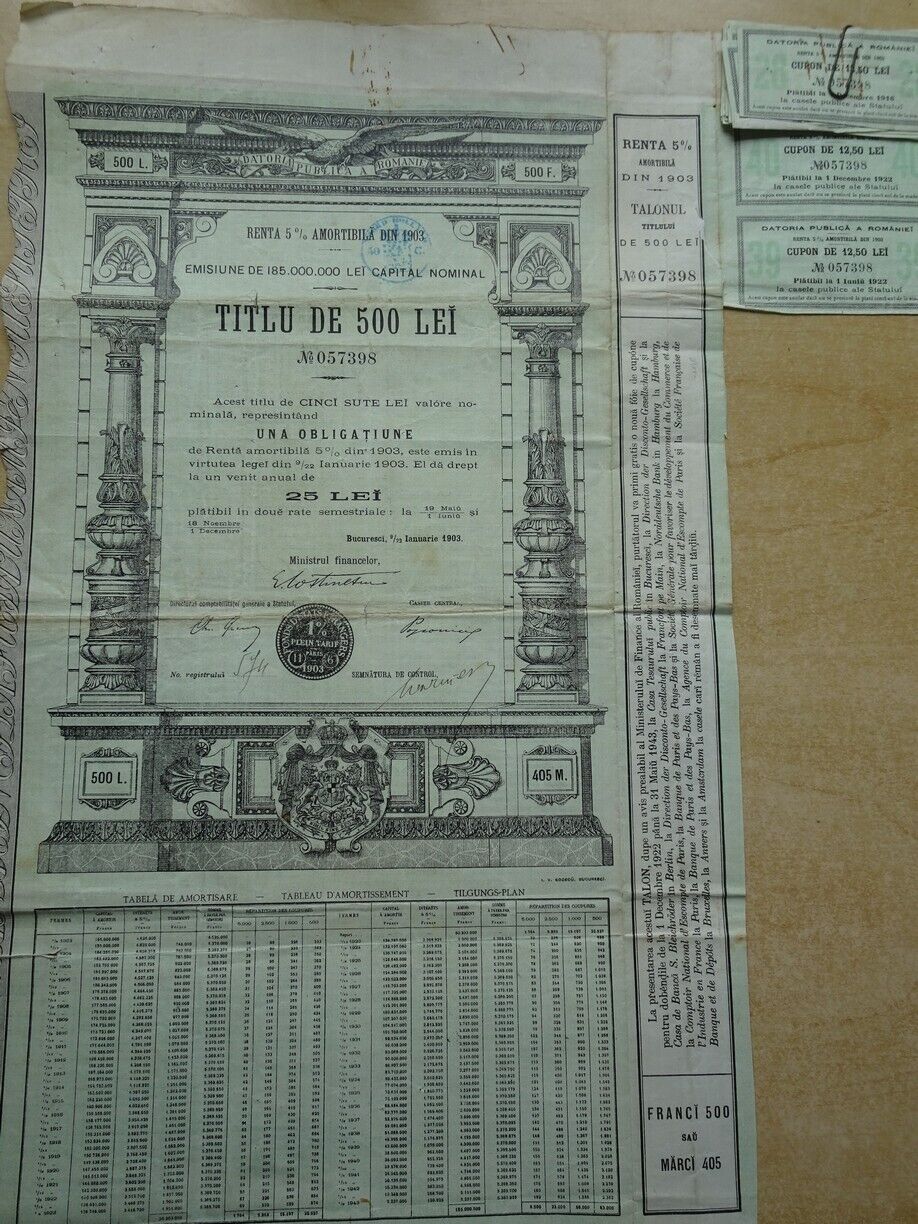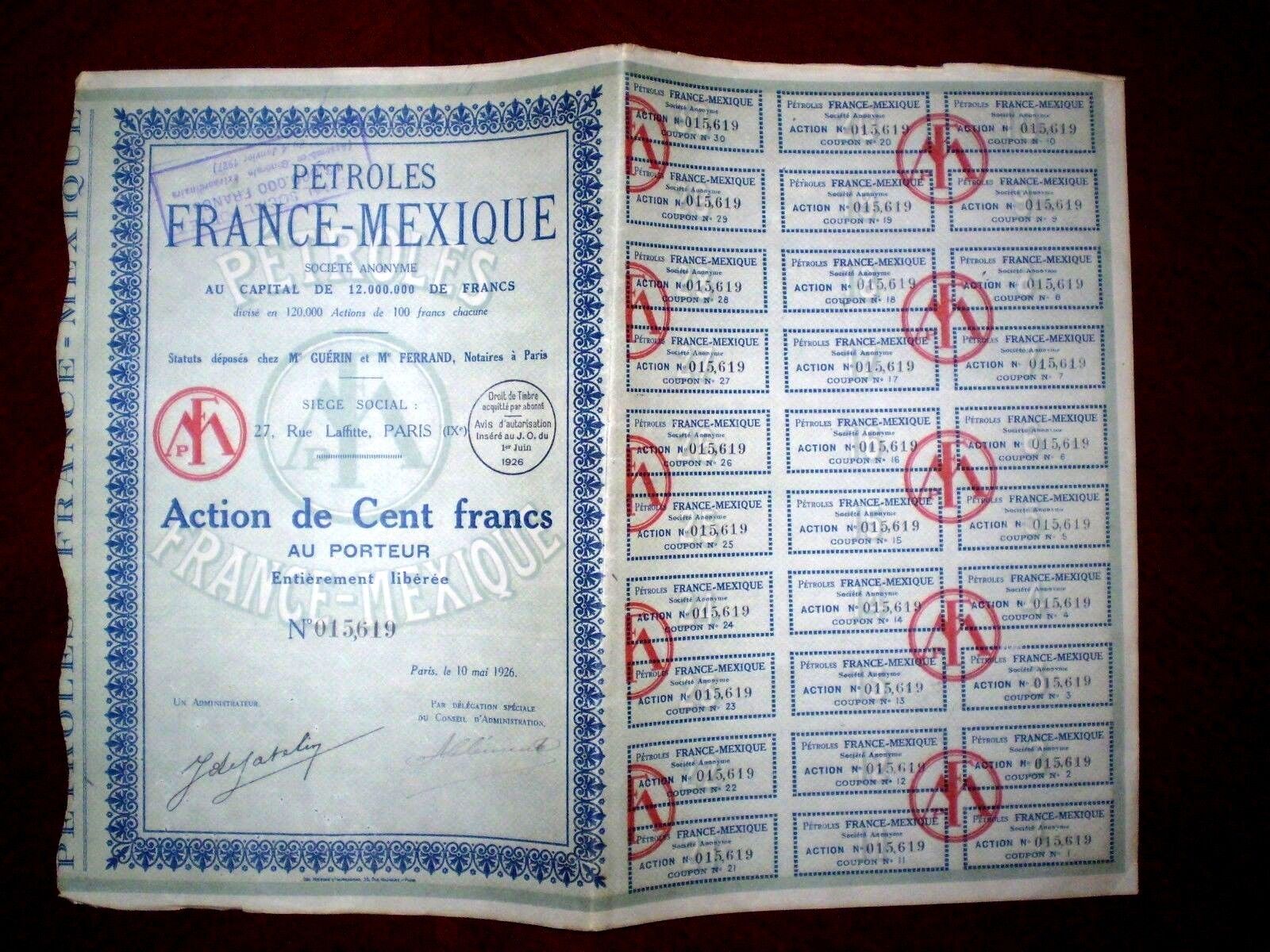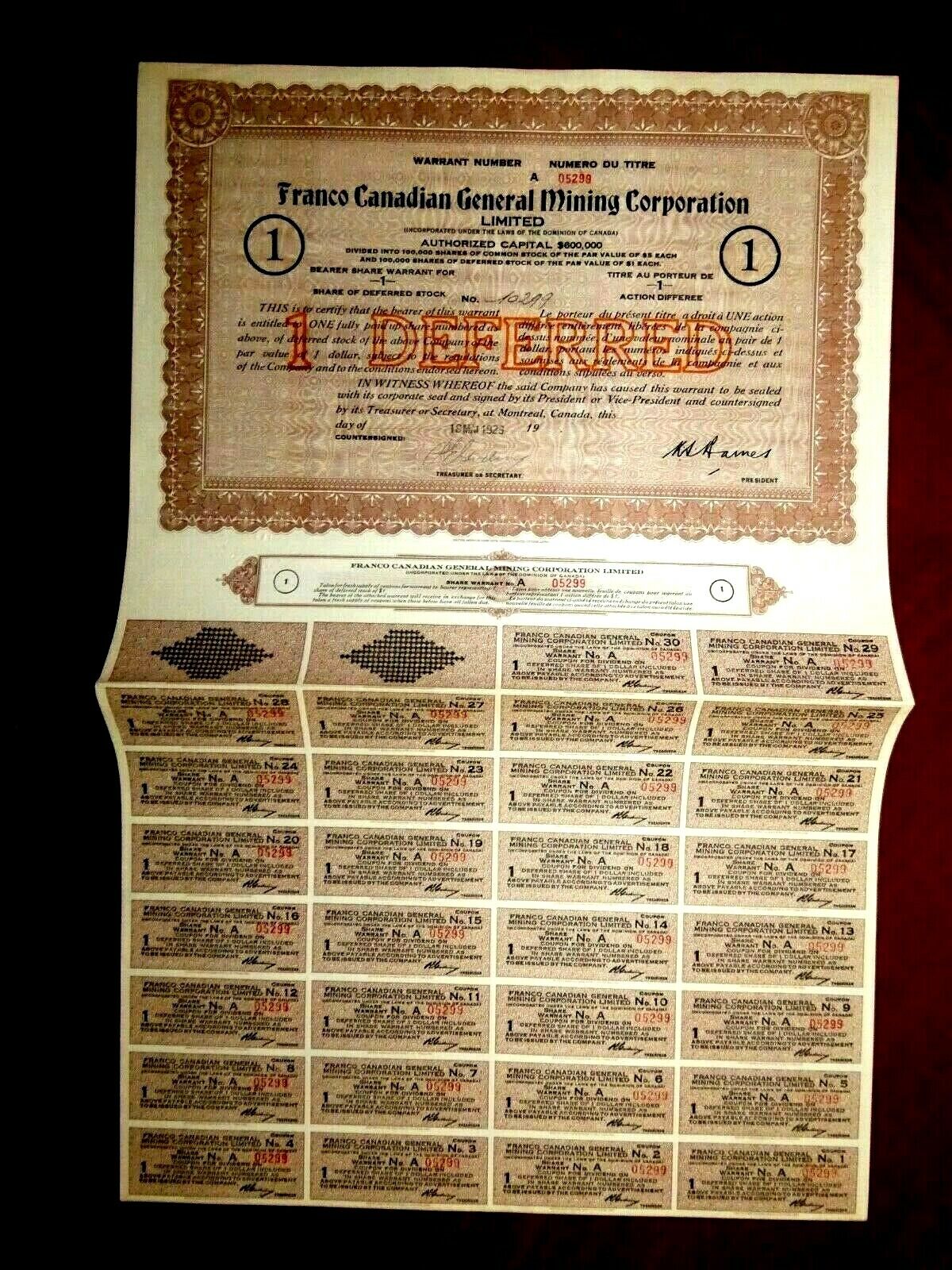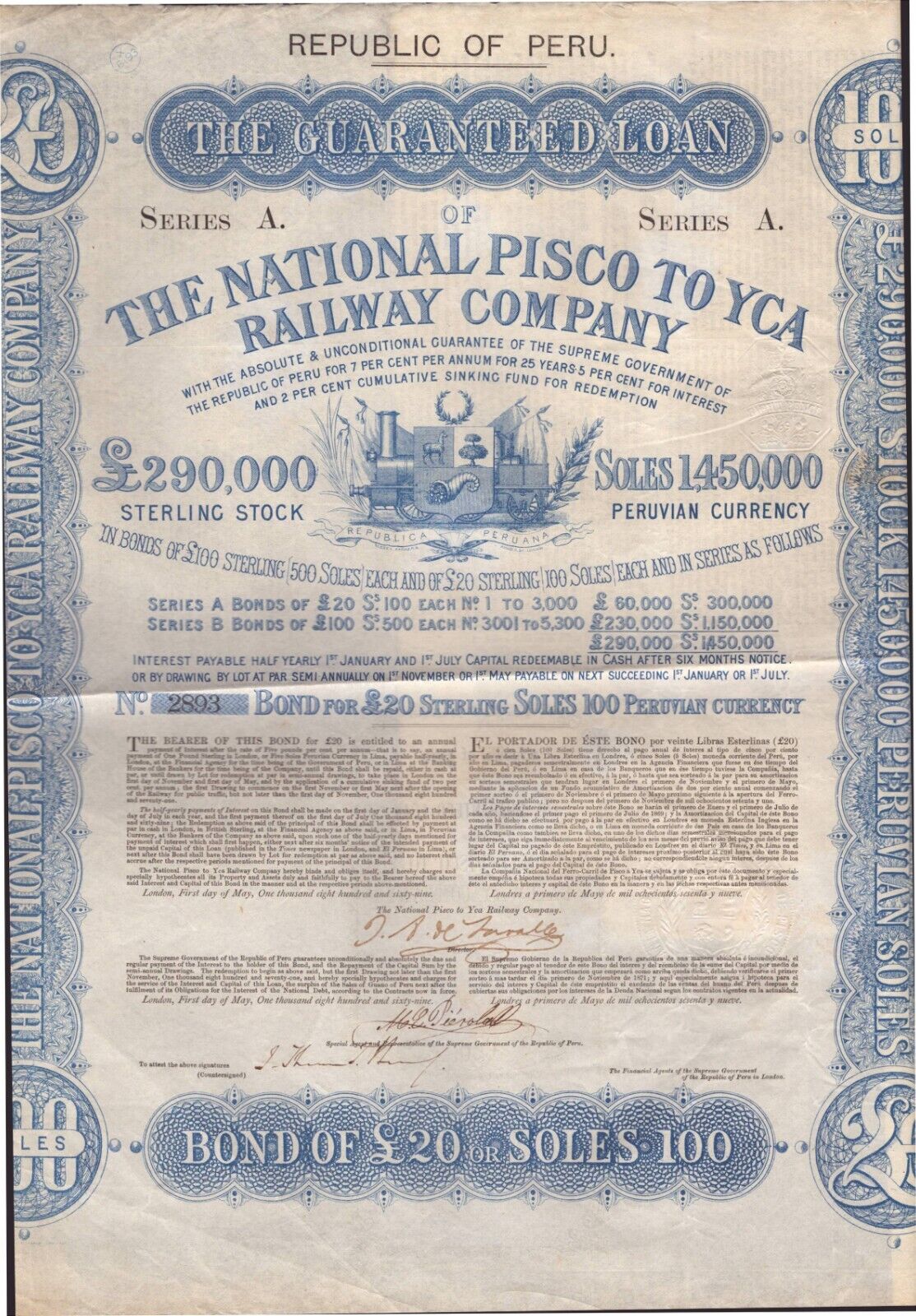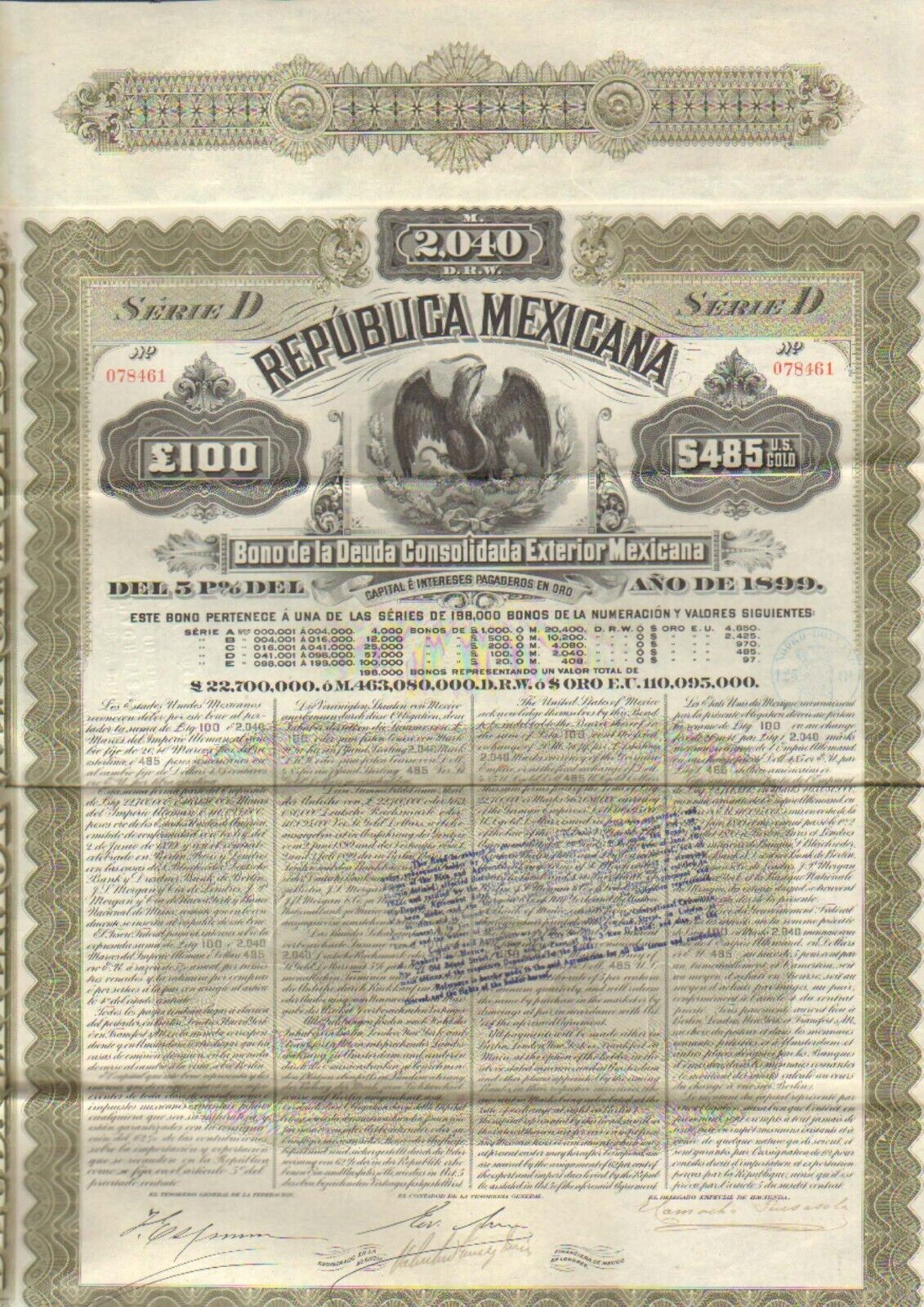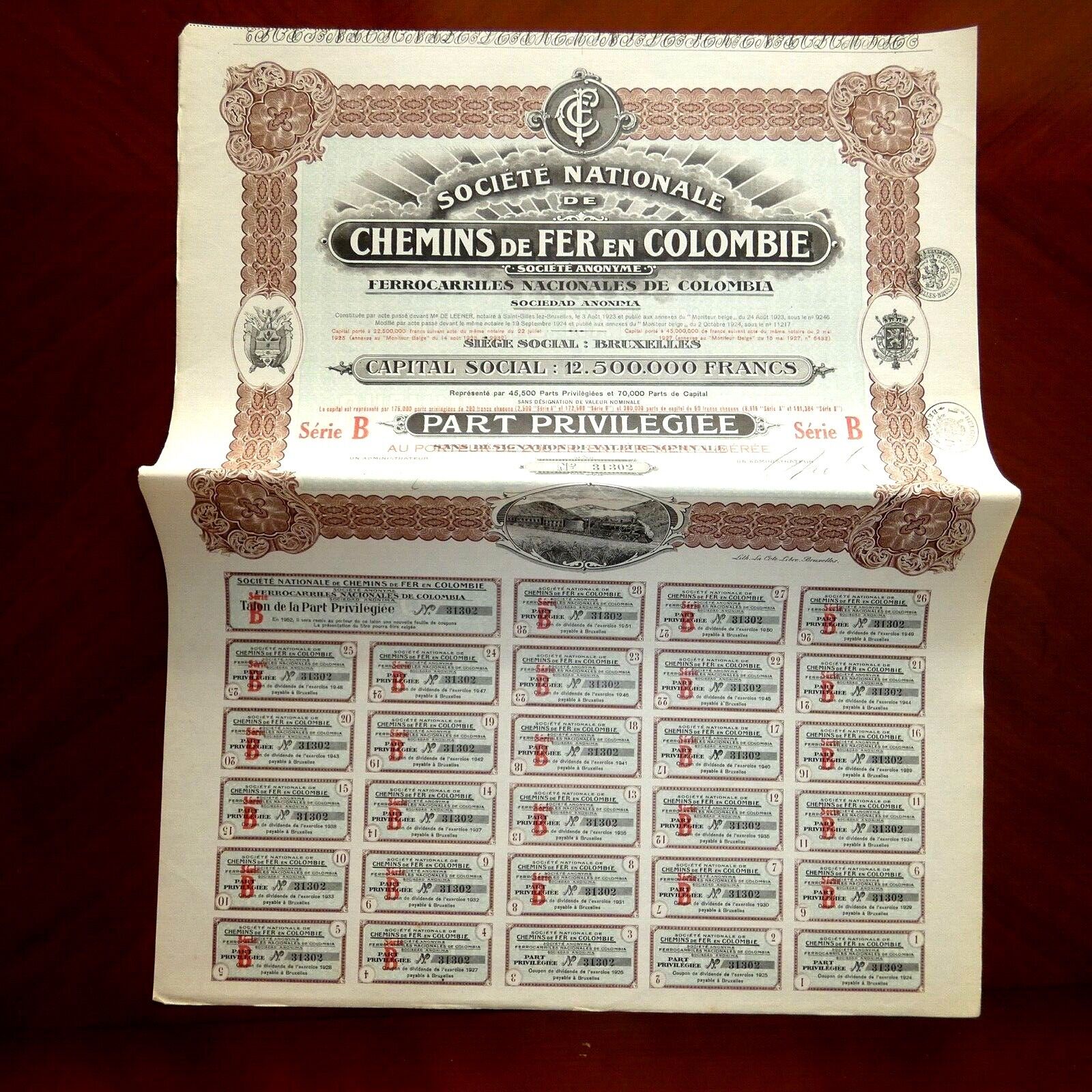-40%
La Colombia, share certificate ,Bordeaux (France) Colombia 1889 500 Francs
$ 9.5
- Description
- Size Guide
Description
One bearer share certificate of :"La Colombia" Société d´études Franco-Belge ,Bordeaux (France) 1889 ,500 Francs .Condition (opinion): Very Fine (VF).See scan. Printer: Imp.Nouvelle A.Bellier er Cie,Bourdeaux (France) .Large item.Size:39 cm /22 cm (size without the coupons).Color:Blue.Uncancelled .Two hand signatures.Contains coupons Nr.1 to Nr.50. Dry seal.Low seral number # 151.See below related information in Spanish and English (online translated).
"
La Colombia"
Company acquired
land in 1892 in San Carlos (Córdoba/Colombia).
-------------------------------------------------------------------------
Postage, including packing material, handling fees : Europe: USD 4.40 / USA $ 5.30. Rest of the World: USD 6.10
FREE of postage for any other items.
Only one shipping charge per shipment (the highest one) no matter how many items you buy (combined shipping).
-----------------------------------------------------------------------------
Guaranteed genuine -
One
month
return
policy
(retail sales) .
Returns accepted with no questions.
Customers are invited to combine purchases to save postage.
Full refund policy ,including shipping cost,guaranteed in case of lost or theft after the completion of the complaint with Spanish Correos for the registered letters (purchases above $ 40.00).
As we have (or could have) more than one identical item ,the serial number may differ from those shown in the picture which is for reference only.
For purchases above .00 we send the orders registered with tracking number without extra charge, for purchases below .00 we ship as regular letters at the buyer's risk.
For purchases below $ 40,00 who want to register your letter with tracking number, please add an extra for : Europe .00 , U.S. .00 ,Rest of the word .00
For some destinations and purchases below .00 customers may be requested for this extra shipping payment in order to register the shipment with tracking number.
If for any reason, your item did not arrive yet, or you are not 100% satisfied with the item you have received, please do not hesitate to contact , I will do all it takes to provide the best service.
Banknote Grading
UNC
AU
EF
VF
F
VG
G
Fair
Poor
Uncirculated
About Uncirculated
Extremely Fine
Very Fine
Fine
Very Good
Good
Fair
Poor
Edges
no counting marks
light counting folds OR...
light counting folds
corners are not fully rounded
much handling on edges
rounded edges
Folds
no folds
...OR one light fold through center
max. three light folds or one strong crease
several horizontal and vertical folds
many folds and creases
Paper
color
paper is clean with bright colors
paper may have minimal dirt or some color smudging, but still crisp
paper is not excessively dirty, but may have some softness
paper may be dirty, discolored or stained
very dirty, discolored and with some writing
very dirty, discolorated, with writing and some obscured portions
very dirty, discolored, with writing and obscured portions
Tears
no tears
no tears into the border
minor tears in the border, but out of design
tears into the design
Holes
no holes
no center hole, but staple hole usual
center hole and staple hole
Integrity
no pieces missing
no large pieces missing
piece missing
piece missing or tape holding pieces together
---------------------------------------------------------------------------------------------------------
One hypothesis
about the history
of
this company is that
it could have been
sold locally
to
American
entrepreneurs
by
French
and
Belgians founders
and
changed the
Company
's name to : "La Colombia
Company"
maybe.
Related information found on the web ,online translated (orientative only):
Sinu Foreign companies (there were none of this
savannas type) were established as enclaves.
Enclave means that natural resource exploitation
and humans in a relatively isolated place, according
working methods and techniques that are subject to the
exchange relations established between the enclave
and foreign capital originating in countries or dominant.
In the production enclaves articulated direct land
mechanisms of regional and international movement, is
proletarianization and rural workers' levels of development are created
unequal slowly can lead to local society
the capitalist mode of production in ways dependent.
Sinuanos enclaves were generally short-lived.
But they left the remains of his ways and large spaces
collapsed and looted jungle, which were transformed
on farms in the hands of others, met the "law of
three steps ": first settler worker and producer,
second the buyer nquero fi improvements, and finally
Squire consolidating lots and monopolizes earth.1
In the enclave of the French Company for the upper Sinú
for gold (1844) Victor worked Dujardin, Luis Striffl er,
Luis Lacharme and others.2 The French Company River
tions cocoa farm adjoined the mother, in the future, the
Naranjo, Pino and Misiguay. Other
French and Belgian
(Georges and Louis Warbrugges)
spot opened by the laughter and Mosquito and constituted
1882 the "Société Agricole du Sinú" to get the cocoa, coffee, rubber,
wood and cattle. When these businesses thrive, in 1894 it became a new
enlarged company, the "Compagnie Française du Rio Sinú" (represented
in Monteria by Dereix, Pedro Enrique Kerguelen and Combat), which
Marta Magdalena bought, laughter and Mosquito. This huge estate was
occupied by the Colombian government concessions, the entire area
Naranjo and understood from the edges of the Sinu River to the peaks of
the Serrania de las Palomas (current limit of the departments of Córdoba
and Antioquia). They were probably initial 10,000 hectares of forest
Virgin, which reached three thousand fell and burn with boys
and arranged by palabreados bush pasture grass to make them
where cattle graze 4000. Also took
to harvest timber na fi. Thus was the "Law of the three steps", which
enriches the owner on the sweat of direct agricultural worker.
The same trends mysterious allure and the looting of our wealth
affected natural enclaves Americans also
approached the Sinu during those years.
"La Colombia"
Company acquired
land in 1892 in San Carlos de Colosiná, who baptized Campanito. There
started gospel hymns sung translated from English to Spanish
by Horace Coleman manager. And workers are wage or piecework
gathered in the "majority" (main house) to pray to the Lord with Pastor
John Jarret after wounding with crust rulas castilloa slingshot
and care for hundreds of pigs crossed with Berkshire in new types
of technical pens. The main food of the animals was the oily
corozo of Noli, which grew in abundance in colorful palm. The
accompanying the march continued evangelical settlers sabaneros
and the high Sinú sinuanos, where they established 22 churches, opened
NCAS fi and founded the town of Nazareth in the thirties, near Valencia,
where he distinguished Juan Libreros Camargo as pastor.
In 1883 came the George D. Emery Company of Boston (USA),
commonly called American Home, the most rapacious of the
foreign companies reached the Sinu. Opened offi ces and large sawmill
in Monteria, where he prepared for export of the vast
that pillaged timber wealth in the middle and upper Sinu until 1915, and the
and San Juan rivers Mulatos between 1915 and 1929.
It is estimated that this company took out 3000 tons of cedar,
oak, mahogany, ceiba veined, and dividive carreto with axes of 400
Anthology of Fals Borda_agosto 13.indd 86 8/14/09 11:11 a.m.
87
and a Belgian brothers to include cocoa and cattle, as well
Woods, in the great estate of Martha Magdalena.3
Americans modifi ed the productive forces:
acquired the property in San Carlos de Campanito Colosiná
(1892) to promote and make the rubber pig,
offi cio also stimulated Ayapel others (1850) and
Turbo (1858). The George D. Emery Company, Boston
(American House with offi ces in Monteria) exploded wood
in the medium and high Sinú between 1883 and 1915 and in the rivers
Mulatos and San Juan, between 1915 and 1929, significant quantities
and prices fabulosos.4 From 1909-1914 worked
Consortium initially Albingia, German, to exploit
Urabá banana, frustrated efforts War
World. There was also a signifi cant immigration
families from Syria and Lebanon, first trade, then
land in business and ganados.5
3Sinú (1894-1913) consolidated holdings of Lacharme
---------------------------------------------------------------------------------
Una hipótesis acerca de la historia de esta compañía es que pudíera haber sido vendida localmente a empresarios Americanos por los fundadores Frnceses y Belgas y cambiado el nomre a La Colombia Company quizás.
Las compañías extranjeras del Sinú (no las hubo de este
tipo en las sabanas) se establecieron en forma de enclaves.
Se entiende por enclave aquella explotación de recursos naturales
y humanos en un lugar relativamente aislado, según
formas de trabajo y técnicas que quedan subordinadas a las
relaciones de intercambio que se establecen entre el enclave
y el capital extranjero en países originarios o dominantes.
En los enclaves se articula la producción directa de la tierra
a mecanismos de circulación regional e internacional, se
proletariza al trabajador rural y se crean niveles de desarrollo
desigual que pueden llevar poco a poco a la sociedad local
al modo de producción capitalista en formas dependientes.
Los enclaves sinuanos fueron en general de corta vida.
Pero dejaron los restos de sus caminos y grandes espacios de
selva derrumbada y saqueada, que se fueron transformando
en haciendas en manos de otros, al cumplirse la “ley de
los tres pasos”: primero el colono trabajador y productor,
segundo el fi nquero comprador de mejoras, y por último
el hacendado que consolida lotes y monopoliza la tierra.1
En el enclave de la Compañía Francesa del alto Sinú para
buscar oro (1844) trabajaron Víctor Dujardín, Luis Striffl er,
Luis Lacharme y otros.2 El de la Compañía Francesa del Río
ciones de cacao que colindaban con la hacienda madre, en El Porvenir, El
Naranjo, Pino y Misiguay. Otros
franceses y belgas
(Georges y Louis Warbrugges)
abrieron por allí mismo a La Risa y Mosquito y constituyeron en
1882 la “Société Agricole du Sinú” para sacar el cacao, el café, el caucho,
maderas y ganado. Al prosperar estos negocios, en 1894 se hizo una nueva
compañía ampliada, la “Compagnie Française du Rio Sinú” (representada
en Montería por los Dereix, Enrique Kerguelen y Pedro Combat), que
compró Marta Magdalena, La Risa y Mosquito. Esta inmensa hacienda fue
ocupando, mediante concesiones del gobierno colombiano, toda el área
comprendida desde el Naranjo y bordes del río Sinú hasta las cumbres de
la serranía de las Palomas (límite actual de los departamentos de Córdoba
y Antioquia). Eran probablemente 10.000 hectáreas iniciales de selva
virgen, de las cuales se alcanzaron a tumbar y quemar tres mil con mozos
y con arreglos palabreados de monte por pasto para convertirlas en potreros
donde pastaran 4.000 cabezas de ganado. Además, aprovecharon
para explotar la madera fi na. Así se cumplió la “Ley de los tres pasos”, que
enriquece al propietario a costa del sudor del trabajador agrícola directo.
La misma atracción misteriosa y tendencias al saqueo de nuestras riquezas
naturales en enclaves afectaron a los norteamericanos, que también
se acercaron al Sinú durante esos años.
La Colombia
Company adquirió
tierras en 1892 en San Carlos de Colosiná, que bautizó Campanito. Allí
empezaron a entonarse himnos evangélicos traducidos del inglés al español
por el gerente Horace Coleman. Y los trabajadores a jornal o a destajo se
reunían en la “mayoría” (casa principal) para orar al Señor con el pastor
Juan Jarret después de herir con sus rulas la corteza de la cauchera castilloa
y de cuidar centenares de cerdos cruzados con Berkshire en nuevos tipos
de chiqueros técnicos. El alimento principal de los animales era el aceitoso
corozo del nolí, que crecía en abundancia en vistosas palmeras. Los
evangélicos siguieron acompañando la marcha de los colonos sabaneros
y sinuanos al alto Sinú, donde establecieron 22 congregaciones, abrieron
fi ncas y fundaron el pueblo de Nazareth en los años treinta, cerca de Valencia,
donde se distinguió Juan Libreros Camargo como pastor.
En 1883 llegó la George D. Emery Company de Boston (Estados Unidos),
comúnmente llamada Casa Americana, la más expoliadora de las
compañías extranjeras que llegaron al Sinú. Abrió ofi cinas y gran aserrío
en Montería, donde se preparaba para la exportación parte de la inmensa
riqueza maderera que saqueó en el Sinú medio y alto hasta 1915, y en los
ríos Mulatos y San Juan entre 1915 y 1929.
Se calcula que esta compañía sacaba 3.000 toneladas anuales de cedro,
roble, caoba, ceiba veteada, carreto y dividive con las hachas de unos 400
Antologia de Fals Borda_agosto 13.indd 86 8/14/09 11:11 AM
87
y unos hermanos belgas para incluir cacao y ganados, además
de maderas, en la gran hacienda de Marta Magdalena.3
Los norteamericanos modifi caron las fuerzas productivas:
adquirieron la hacienda Campanito en San Carlos de Colosiná
(1892) para fomentar la porcicultura y sacar el caucho,
ofi cio que también estimularon otros en Ayapel (1850) y
Turbo (1858). La George D. Emery Company, de Boston
(la Casa Americana con ofi cinas en Montería) explotó maderas
en el medio y alto Sinú entre 1883 y 1915 y en los ríos
Mulatos y San Juan, entre 1915 y 1929, en cantidades considerables
y con precios fabulosos.4 De 1909 a 1914 funcionó
inicialmente el Consorcio Albingia, alemán, para explotar
banano en Urabá, empeño frustrado por la Primera Guerra
Mundial. También hubo una signifi cativa inmigración de
familias de Siria y el Líbano, primero en el comercio, luego
en el negocio de tierras y ganados.5
3Sinú (1894-1913) consolidó explotaciones de los Lacharme
Deshacer cambios
Your browser does not support JavaScript. To view this page, enable JavaScript if it is disabled or upgrade your browser.




